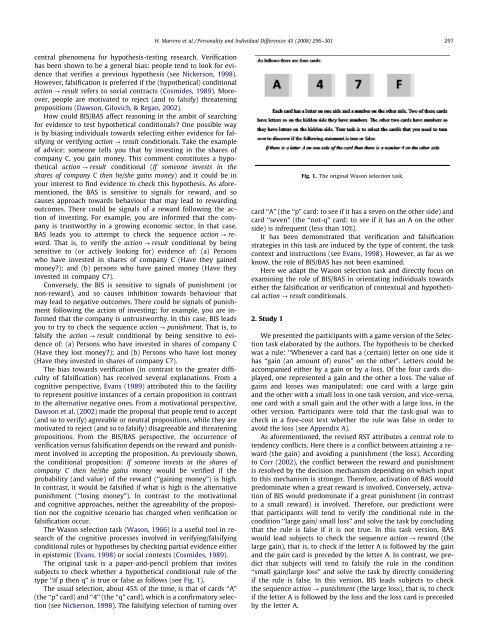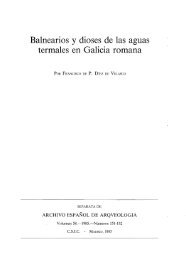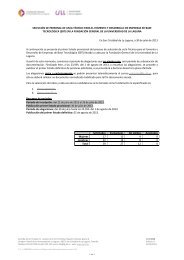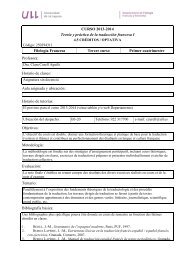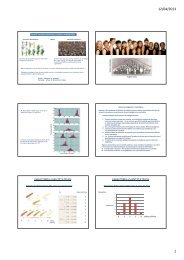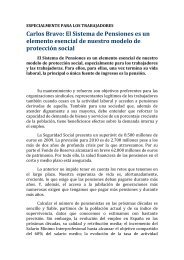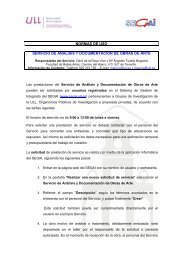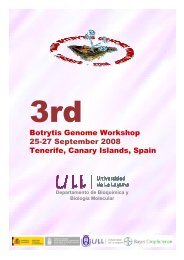BIS/BAS individual differences and the verification of conditional ...
BIS/BAS individual differences and the verification of conditional ...
BIS/BAS individual differences and the verification of conditional ...
Create successful ePaper yourself
Turn your PDF publications into a flip-book with our unique Google optimized e-Paper software.
H. Marrero et al. / Personality <strong>and</strong> Individual Differences 45 (2008) 296–301 297central phenomena for hypo<strong>the</strong>sis-testing research. Verificationhas been shown to be a general bias: people tend to look for evidencethat verifies a previous hypo<strong>the</strong>sis (see Nickerson, 1998).However, falsification is preferred if <strong>the</strong> (hypo<strong>the</strong>tical) <strong>conditional</strong>action ? result refers to social contracts (Cosmides, 1989). Moreover,people are motivated to reject (<strong>and</strong> to falsify) threateningpropositions (Dawson, Gilovich, & Regan, 2002).How could <strong>BIS</strong>/<strong>BAS</strong> affect reasoning in <strong>the</strong> ambit <strong>of</strong> searchingfor evidence to test hypo<strong>the</strong>tical <strong>conditional</strong>s? One possible wayis by biasing <strong>individual</strong>s towards selecting ei<strong>the</strong>r evidence for falsifyingor verifying action ? result <strong>conditional</strong>s. Take <strong>the</strong> example<strong>of</strong> advice; someone tells you that by investing in <strong>the</strong> shares <strong>of</strong>company C, you gain money. This comment constitutes a hypo<strong>the</strong>ticalaction ? result <strong>conditional</strong> (If someone invests in <strong>the</strong>shares <strong>of</strong> company C <strong>the</strong>n he/she gains money) <strong>and</strong> it could be inyour interest to find evidence to check this hypo<strong>the</strong>sis. As aforementioned,<strong>the</strong> <strong>BAS</strong> is sensitive to signals for reward, <strong>and</strong> socauses approach towards behaviour that may lead to rewardingoutcomes. There could be signals <strong>of</strong> a reward following <strong>the</strong> action<strong>of</strong> investing. For example, you are informed that <strong>the</strong> companyis trustworthy in a growing economic sector. In that case,<strong>BAS</strong> leads you to attempt to check <strong>the</strong> sequence action ? reward.That is, to verify <strong>the</strong> action ? result <strong>conditional</strong> by beingsensitive to (or actively looking for) evidence <strong>of</strong>: (a) Personswho have invested in shares <strong>of</strong> company C (Have <strong>the</strong>y gainedmoney?); <strong>and</strong> (b) persons who have gained money (Have <strong>the</strong>yinvested in company C?).Conversely, <strong>the</strong> <strong>BIS</strong> is sensitive to signals <strong>of</strong> punishment (ornon-reward), <strong>and</strong> so causes inhibition towards behaviour thatmay lead to negative outcomes. There could be signals <strong>of</strong> punishmentfollowing <strong>the</strong> action <strong>of</strong> investing; for example, you are informedthat <strong>the</strong> company is untrustworthy. In this case, <strong>BIS</strong> leadsyou to try to check <strong>the</strong> sequence action ? punishment. That is, t<strong>of</strong>alsify <strong>the</strong> action ? result <strong>conditional</strong> by being sensitive to evidence<strong>of</strong>: (a) Persons who have invested in shares <strong>of</strong> company C(Have <strong>the</strong>y lost money?); <strong>and</strong> (b) Persons who have lost money(Have <strong>the</strong>y invested in shares <strong>of</strong> company C?).The bias towards <strong>verification</strong> (in contrast to <strong>the</strong> greater difficulty<strong>of</strong> falsification) has received several explanations. From acognitive perspective, Evans (1989) attributed this to <strong>the</strong> facilityto represent positive instances <strong>of</strong> a certain proposition in contrastto <strong>the</strong> alternative negative ones. From a motivational perspective,Dawson et al. (2002) made <strong>the</strong> proposal that people tend to accept(<strong>and</strong> so to verify) agreeable or neutral propositions, while <strong>the</strong>y aremotivated to reject (<strong>and</strong> so to falsify) disagreeable <strong>and</strong> threateningpropositions. From <strong>the</strong> <strong>BIS</strong>/<strong>BAS</strong> perspective, <strong>the</strong> occurrence <strong>of</strong><strong>verification</strong> versus falsification depends on <strong>the</strong> reward <strong>and</strong> punishmentinvolved in accepting <strong>the</strong> proposition. As previously shown,<strong>the</strong> <strong>conditional</strong> proposition: If someone invests in <strong>the</strong> shares <strong>of</strong>company C <strong>the</strong>n he/she gains money would be verified if <strong>the</strong>probability (<strong>and</strong> value) <strong>of</strong> <strong>the</strong> reward (‘‘gaining money”) is high.In contrast, it would be falsified if what is high is <strong>the</strong> alternativepunishment (‘‘losing money”). In contrast to <strong>the</strong> motivational<strong>and</strong> cognitive approaches, nei<strong>the</strong>r <strong>the</strong> agreeability <strong>of</strong> <strong>the</strong> propositionnor <strong>the</strong> cognitive scenario has changed when <strong>verification</strong> orfalsification occur.The Wason selection task (Wason, 1966) is a useful tool in research<strong>of</strong> <strong>the</strong> cognitive processes involved in verifying/falsifying<strong>conditional</strong> rules or hypo<strong>the</strong>ses by checking partial evidence ei<strong>the</strong>rin epistemic (Evans, 1998) or social contexts (Cosmides, 1989).The original task is a paper-<strong>and</strong>-pencil problem that invitessubjects to check whe<strong>the</strong>r a hypo<strong>the</strong>tical <strong>conditional</strong> rule <strong>of</strong> <strong>the</strong>type ‘‘if p <strong>the</strong>n q” is true or false as follows (see Fig. 1).The usual selection, about 45% <strong>of</strong> <strong>the</strong> time, is that <strong>of</strong> cards ‘‘A”(<strong>the</strong> ‘‘p” card) <strong>and</strong> ‘‘4” (<strong>the</strong> ‘‘q” card), which is a confirmatory selection(see Nickerson, 1998). The falsifying selection <strong>of</strong> turning overcard ‘‘A” (<strong>the</strong> ‘‘p” card: to see if it has a seven on <strong>the</strong> o<strong>the</strong>r side) <strong>and</strong>card ‘‘seven” (<strong>the</strong> ‘‘not-q” card: to see if it has an A on <strong>the</strong> o<strong>the</strong>rside) is infrequent (less than 10%).It has been demonstrated that <strong>verification</strong> <strong>and</strong> falsificationstrategies in this task are induced by <strong>the</strong> type <strong>of</strong> content, <strong>the</strong> taskcontext <strong>and</strong> instructions (see Evans, 1998). However, as far as weknow, <strong>the</strong> role <strong>of</strong> <strong>BIS</strong>/<strong>BAS</strong> has not been examined.Here we adapt <strong>the</strong> Wason selection task <strong>and</strong> directly focus onexamining <strong>the</strong> role <strong>of</strong> <strong>BIS</strong>/<strong>BAS</strong> in orientating <strong>individual</strong>s towardsei<strong>the</strong>r <strong>the</strong> falsification or <strong>verification</strong> <strong>of</strong> contextual <strong>and</strong> hypo<strong>the</strong>ticalaction ? result <strong>conditional</strong>s.2. Study 1Fig. 1. The original Wason selection task.We presented <strong>the</strong> participants with a game version <strong>of</strong> <strong>the</strong> Selectiontask elaborated by <strong>the</strong> authors. The hypo<strong>the</strong>sis to be checkedwas a rule: ‘‘Whenever a card has a (certain) letter on one side ithas ‘‘gain (an amount <strong>of</strong>) euros” on <strong>the</strong> o<strong>the</strong>r”. Letters could beaccompanied ei<strong>the</strong>r by a gain or by a loss. Of <strong>the</strong> four cards displayed,one represented a gain <strong>and</strong> <strong>the</strong> o<strong>the</strong>r a loss. The value <strong>of</strong>gains <strong>and</strong> losses was manipulated: one card with a large gain<strong>and</strong> <strong>the</strong> o<strong>the</strong>r with a small loss in one task version, <strong>and</strong> vice-versa,one card with a small gain <strong>and</strong> <strong>the</strong> o<strong>the</strong>r with a large loss, in <strong>the</strong>o<strong>the</strong>r version. Participants were told that <strong>the</strong> task-goal was tocheck in a free-cost test whe<strong>the</strong>r <strong>the</strong> rule was false in order toavoid <strong>the</strong> loss (see Appendix A).As aforementioned, <strong>the</strong> revised RST attributes a central role totendency conflicts. Here <strong>the</strong>re is a conflict between attaining a reward(<strong>the</strong> gain) <strong>and</strong> avoiding a punishment (<strong>the</strong> loss). Accordingto Corr (2002), <strong>the</strong> conflict between <strong>the</strong> reward <strong>and</strong> punishmentis resolved by <strong>the</strong> decision mechanism depending on which inputto this mechanism is stronger. Therefore, activation <strong>of</strong> <strong>BAS</strong> wouldpredominate when a great reward is involved. Conversely, activation<strong>of</strong> <strong>BIS</strong> would predominate if a great punishment (in contrastto a small reward) is involved. Therefore, our predictions werethat participants will tend to verify <strong>the</strong> <strong>conditional</strong> rule in <strong>the</strong>condition ‘‘large gain/ small loss” <strong>and</strong> solve <strong>the</strong> task by concludingthat <strong>the</strong> rule is false if it is not true. In this task version, <strong>BAS</strong>would lead subjects to check <strong>the</strong> sequence action ? reward (<strong>the</strong>large gain), that is, to check if <strong>the</strong> letter A is followed by <strong>the</strong> gain<strong>and</strong> <strong>the</strong> gain card is preceded by <strong>the</strong> letter A. In contrast, we predictthat subjects will tend to falsify <strong>the</strong> rule in <strong>the</strong> condition‘‘small gain/large loss” <strong>and</strong> solve <strong>the</strong> task by directly consideringif <strong>the</strong> rule is false. In this version, <strong>BIS</strong> leads subjects to check<strong>the</strong> sequence action ? punishment (<strong>the</strong> large loss), that is, to checkif <strong>the</strong> letter A is followed by <strong>the</strong> loss <strong>and</strong> <strong>the</strong> loss card is precededby <strong>the</strong> letter A.


